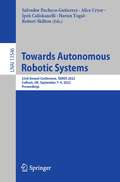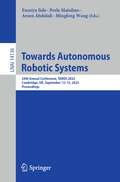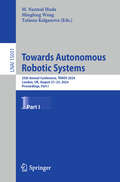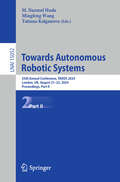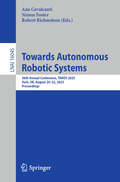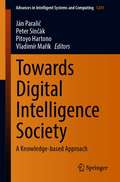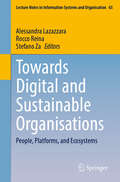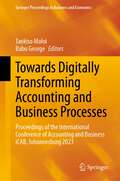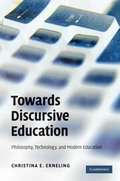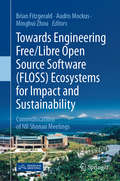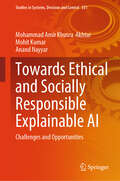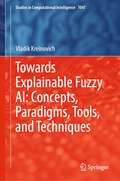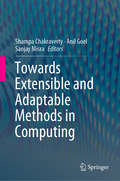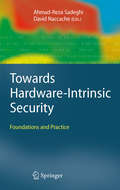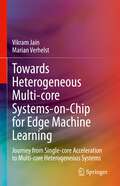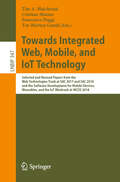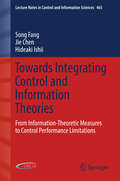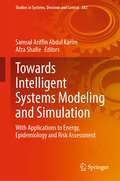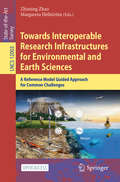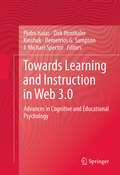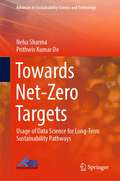- Table View
- List View
Towards Autonomous Robotic Systems: 23rd Annual Conference, TAROS 2022, Culham, UK, September 7–9, 2022, Proceedings (Lecture Notes in Computer Science #13546)
by Salvador Pacheco-Gutierrez Alice Cryer Ipek Caliskanelli Harun Tugal Robert SkiltonThe volume LNAI 13546 constitutes the refereed proceedings of the 23rd Annual Conference Towards Autonomous Robotic Systems, TAROS 2022, held in Culham, UK, in September 2022. The 14 full papers and 10 short papers were carefully reviewed and selected from 38 submissions. Organized in the topical sections "Algorithms" and "Systems", they discuss significant findings and advances in the following areas: Robotic Grippers and Manipulation; Soft Robotics, Sensing and Mobile Robots; Robotic Learning, Mapping and Planning; Robotic Systems and Applications.
Towards Autonomous Robotic Systems: 24th Annual Conference, TAROS 2023, Cambridge, UK, September 13–15, 2023, Proceedings (Lecture Notes in Computer Science #14136)
by Fumiya Iida Perla Maiolino Arsen Abdulali Mingfeng WangThis book constitutes the refereed proceedings of the 24th Annual Conference Towards Autonomous Robotic Systems, TAROS 2023, held in Cambridge, UK, during September 13–15, 2023.The 40 full papers presented in this book were carefully reviewed and selected from 70 submissions.They cover a wide range of different topics such as: agri-food robotics; autonomy; collaborative and service robotics; locomotion and manipulation; machine vision; multi-robot systems; soft robotics; tactile sensing; and teleoperation.
Towards Autonomous Robotic Systems: 25th Annual Conference, TAROS 2024, London, UK, August 21–23, 2024, Proceedings, Part I (Lecture Notes in Computer Science #15051)
by Mingfeng Wang M. Nazmul Huda Tatiana KalganovaThis two-volume set, LNAI 15051-15052, constitutes the refereed proceedings from the 25th Annual Conference Towards Autonomous Robotic Systems, TAROS 2024, held in London, UK, during August 21-23, 2024. The 54 full papers and 11 short papers presented in these volumes were carefully reviewed and selected from 69 submissions. The papers presented in these two volumes are organized in the following topical sections: - Part I: Robotic Learning, Mapping and Planning; Robotic Modeling, Sensing and Control; Machine Vision. Part II: Human-Robot Interaction/Collaboration; Locomotion and Manipulation; Mechanism Design; Soft Robotics; Swarms and Multi-Agent Systems.
Towards Autonomous Robotic Systems: 25th Annual Conference, TAROS 2024, London, UK, August 21–23, 2024, Proceedings, Part II (Lecture Notes in Computer Science #15052)
by Mingfeng Wang M. Nazmul Huda Tatiana KalganovaThis two-volume set, LNAI 15051-15052, constitutes the refereed proceedings from the 25th Annual Conference Towards Autonomous Robotic Systems, TAROS 2024, held in London, UK, during August 21-23, 2024. The 54 full papers and 11 short papers presented in these volumes were carefully reviewed and selected from 69 submissions. The papers presented in these two volumes are organized in the following topical sections: - Part I: Robotic Learning, Mapping and Planning; Robotic Modeling, Sensing and Control; Machine Vision. Part II: Human-Robot Interaction/Collaboration; Locomotion and Manipulation; Mechanism Design; Soft Robotics; Swarms and Multi-Agent Systems.
Towards Autonomous Robotic Systems: 26th Annual Conference, TAROS 2025, York, UK, August 20–22, 2025, Proceedings (Lecture Notes in Computer Science #16045)
by Robert Richardson Ana Cavalcanti Simon FosterThis LNAI 16045 volume constitutes the proceedings of the 26th Annual Conference on Towards Autonomous Robotic Systems, TAROS 2025, held in York, UK, duing August 20–22, 2025. The 32 full papers and 4 short papers, together with 4 invited papers presented in these volumes were carefully reviewed and selected from 74 submissions. The papers were categorised into seven groups: Human-Robot Interaction and Teleoperation, Sensing and Perception, Locomotion and Control, Manipulation and Dexterous Interaction, Software Engineering for Robotics, Underwater Robotics and Autonomy, Aerial Robotics and Path Planning, and Challenging Environments.
Towards Cognitive IoT Networks (Internet of Things)
by Mohammad Abdul MatinThis book gathers state-of-the-art research contributions written by academics and researchers, which address emerging trends in system design and implementation for the Internet of Things (IoT), and discuss how to promote IoT technologies and applications. The book is chiefly intended for researchers and academics who want to get caught up with the latest trends in enabling technologies for IoT and related applications and services. However, it also includes chapters on the fundamentals of IoT, offering essential orientation for general readers.
Towards Digital Intelligence Society: A Knowledge-based Approach (Advances in Intelligent Systems and Computing #1281)
by Vladimír Mařík Pitoyo Hartono Peter Sinčák Ján ParaličThis book aims to provide readers with up-to-date knowledge on how to make these technologies smarter. Humanity is now going through difficult times to fight the Covid-19 pandemic. Simultaneously, in these difficult times of physical separation, we can also realize how much digital society technology helps us cope with many difficulties that bring us this time. The authors focus on selected research challenges for intelligent digital society and state-of-the-art methods of how to face them. The book’s subtitle suggests that a core concept that the reader can study from various points of view in particular book chapters is the knowledge. The knowledge that can help us intelligently face different digital society challenges (Part I of this book); the knowledge extracted from available big data employing intelligent analysis techniques (Part II). For efficient processing and analysis of data, there is a strong need for smart data and information modeling techniques (Part III).
Towards Digital and Sustainable Organisations: People, Platforms, and Ecosystems (Lecture Notes in Information Systems and Organisation #65)
by Stefano Za Alessandra Lazazzara Rocco ReinaThis book presents a collection of research papers that explore how ICT experts, managers, and policymakers can address sustainability issues in digital transformation (DT) by considering people practices, organizational processes, and platform design issues. Each chapter offers insights into how to create sustainable digital solutions that benefit both society and the environment. The diversity of views presented makes this book particularly relevant for scholars, companies, and public sector organizations. The content is based on revised versions of selected papers (original double-blind peer-reviewed contributions) presented at the annual conference of the Italian Chapter of AIS, which took place in Catanzaro, Italy, in October 2022.
Towards Digitally Transforming Accounting and Business Processes: Proceedings of the International Conference of Accounting and Business iCAB, Johannesburg 2023 (Springer Proceedings in Business and Economics)
by Babu George Tankiso MoloiThis conference volume discusses the findings of the iCAB 2023 conference that took place in Johannesburg, South Africa. The University of Johannesburg (UJ School of Accounting and Johannesburg Business School) in collaboration with Alcorn State University (USA), Salem State University (USA) and Universiti Teknologi Mara (Malaysia) hosted the iCAB 2023 conference with the aim to bring together researchers from different Accounting and Business Management fields to share ideas and discuss how new disruptive technological developments are impacting the field of accounting. The conference was sponsored by the Association of International Certified Professional Accountants AICPA & CIMA.
Towards Discursive Education: Philosophy, Technology, and Modern Education
by Christina E. ErnelingAs technology continues to advance, the use of computers and the Internet in educational environments has immensely increased. But just how effective has their use been in enhancing children's learning? In this thought-provoking book, Christina E. Erneling conducts a thorough investigation of scholarly journal articles on how computers and the Internet affect learning. She critiques the influential pedagogical theories informing the use of computers in schools - in particular those of Jean Piaget and 'theory of mind' psychology. Erneling introduces and argues for a discursive approach to learning based on the philosophy of Ludwig Wittgenstein and the psychology of Lev Vygotsky. This book not only addresses an urgent pedagogical problem in depth, but also challenges dominant assumptions about learning in both developmental psychology and cognitive science.
Towards Engineering Free/Libre Open Source Software (FLOSS) Ecosystems for Impact and Sustainability: Communications of NII Shonan Meetings
by Brian Fitzgerald Audris Mockus Minghui ZhouFree/libre open source software (FLOSS) ecosystems such as Linux have had a tremendous impact on computing and society and have captured the attention of businesses, researchers, and policy makers. Research on FLOSS has been ongoing for almost two decades. From an economic perspective, the most common topics involve motivation and organization. As commercial participation in FLOSS has become common, the question of how to combine FLOSS practice with commercial practice has been the subject of research, particularly with a view to understanding how to ensure sustainability of the ecosystem. This book is based on a Shonan meeting on FLOSS ecosystem sustainability held in June 2017. The meeting brought together a blend of established and young researchers who were actively studying the FLOSS phenomenon. These researchers were drawn from a variety of disciplines including software engineering, human computer interaction, information systems, computer-supported cooperative work, data mining, cognitive science, psychology, operations research, and management. Industry practitioners who were active in the FLOSS space also participated. This book presents the results of discussion on fundamental questions related to the impact and sustainability of FLOSS ecosystems, including: · How does an ecosystem form? How do different stakeholders work together to form a community that develops and maintains valuable and freely available software, and how does an ecosystem with millions of repositories and developers operate given the lack of centralized planning? · How does an ecosystem evolve in response to the environment as technology and needs evolve over time?· How do newcomers learn the protocols and practices of an ecosystem? How would they sustain the ecosystem? What is the relationship between people and ecosystem sustainability?
Towards Ethical and Socially Responsible Explainable AI: Challenges and Opportunities (Studies in Systems, Decision and Control #551)
by Anand Nayyar Mohit Kumar Mohammad Amir Akhtar"Dive deep into the evolving landscape of AI with 'Towards Ethical and Socially Responsible Explainable AI'. This transformative book explores the profound impact of AI on society, emphasizing transparency, accountability, and fairness in decision-making processes. It offers invaluable insights into creating AI systems that not only perform effectively but also uphold ethical standards and foster trust. Essential reading for technologists, policymakers, and all stakeholders invested in shaping a responsible AI future."
Towards Explainable Fuzzy AI: Concepts, Paradigms, Tools, and Techniques (Studies in Computational Intelligence #1047)
by Vladik KreinovichModern AI techniques –- especially deep learning –- provide, in many cases, very good recommendations: where a self-driving car should go, whether to give a company a loan, etc. The problem is that not all these recommendations are good -- and since deep learning provides no explanations, we cannot tell which recommendations are good. It is therefore desirable to provide natural-language explanation of the numerical AI recommendations. The need to connect natural language rules and numerical decisions is known since 1960s, when the need emerged to incorporate expert knowledge -- described by imprecise words like "small" -- into control and decision making. For this incorporation, a special "fuzzy" technique was invented, that led to many successful applications. This book described how this technique can help to make AI more explainable.The book can be recommended for students, researchers, and practitioners interested in explainable AI.
Towards Extensible and Adaptable Methods in Computing
by Sanjay Misra Shampa Chakraverty Anil GoelThis book addresses extensible and adaptable computing, a broad range of methods and techniques used to systematically tackle the future growth of systems and respond proactively and seamlessly to change. The book is divided into five main sections: Agile Software Development, Data Management, Web Intelligence, Machine Learning and Computing in Education. These sub-domains of computing work together in mutually complementary ways to build systems and applications that scale well, and which can successfully meet the demands of changing times and contexts. The topics under each track have been carefully selected to highlight certain qualitative aspects of applications and systems, such as scalability, flexibility, integration, efficiency and context awareness. The first section (Agile Software Development) includes six contributions that address related issues, including risk management, test case prioritization and tools, open source software reliability and predicting the change proneness of software. The second section (Data Management) includes discussions on myriad issues, such as extending database caches using solid-state devices, efficient data transmission, healthcare applications and data security. In turn, the third section (Machine Learning) gathers papers that investigate ML algorithms and present their specific applications such as portfolio optimization, disruption classification and outlier detection. The fourth section (Web Intelligence) covers emerging applications such as metaphor detection, language identification and sentiment analysis, and brings to the fore web security issues such as fraud detection and trust/reputation systems. In closing, the fifth section (Computing in Education) focuses on various aspects of computer-aided pedagogical methods.
Towards Hardware-Intrinsic Security
by Ahmad-Reza Sadeghi David Naccache Pim TuylsHardware-intrinsic security is a young field dealing with secure secret key storage. By generating the secret keys from the intrinsic properties of the silicon, e.g., from intrinsic Physical Unclonable Functions (PUFs), no permanent secret key storage is required anymore, and the key is only present in the device for a minimal amount of time. The field is extending to hardware-based security primitives and protocols such as block ciphers and stream ciphers entangled with the hardware, thus improving IC security. While at the application level there is a growing interest in hardware security for RFID systems and the necessary accompanying system architectures. This book brings together contributions from researchers and practitioners in academia and industry, an interdisciplinary group with backgrounds in physics, mathematics, cryptography, coding theory and processor theory. It will serve as important background material for students and practitioners, and will stimulate much further research and development.
Towards Heterogeneous Multi-core Systems-on-Chip for Edge Machine Learning: Journey from Single-core Acceleration to Multi-core Heterogeneous Systems
by Marian Verhelst Vikram JainThis book explores and motivates the need for building homogeneous and heterogeneous multi-core systems for machine learning to enable flexibility and energy-efficiency. Coverage focuses on a key aspect of the challenges of (extreme-)edge-computing, i.e., design of energy-efficient and flexible hardware architectures, and hardware-software co-optimization strategies to enable early design space exploration of hardware architectures. The authors investigate possible design solutions for building single-core specialized hardware accelerators for machine learning and motivates the need for building homogeneous and heterogeneous multi-core systems to enable flexibility and energy-efficiency. The advantages of scaling to heterogeneous multi-core systems are shown through the implementation of multiple test chips and architectural optimizations.
Towards Industry 5.0: Selected Papers from ISPR2022, October 6–8, 2022, Antalya (Lecture Notes in Mechanical Engineering)
by Numan M. Durakbasa M. Güneş GençyılmazThis book contains selected papers from International Symposium for Production Research 2022, held on October 6–9, 2022, Turkey. The book reports recent advances in production engineering and operations. It explores topics including:production research;production management; operations management;industry 4.0;industrial engineering;mechanical engineering;engineering management; andoperational research.Presenting real-life applications, case studies, and mathematical models, this book is of interest to researchers, academics, and practitioners in the field of production and operation engineering. It provides both the results of recent research and practical solutions to real-world problems.
Towards Integrated Web, Mobile, and IoT Technology: Selected and Revised Papers from the Web Technologies Track at SAC 2017 and SAC 2018, and the Software Development for Mobile Devices, Wearables, and the IoT Minitrack at HICSS 2018 (Lecture Notes in Business Information Processing #347)
by Francesco Poggi Tim A. Majchrzak Cristian Mateos Tor-Morten GrønliThis book deals with integrated Web, mobile, and IoT technologies. Novel approaches and techniques, new tools and frameworks are needed to address the increasing complexity of the distributed computing paradigms that are coming and the applications therein.This volume contains selected and extended papers from a) the Web Technologies track at the 33rd ACM/SIGAPP Symposium On Applied Computing, b) the Web Technologies track at the 32nd ACM/SIGAPP Symposium On Applied Computing, and c) the Software Development for Mobile Devices, Wearables, and the Internet-of-Things Minitrack at the 51st Hawaii International Conference on System Sciences. Overall, it provides a uniform view of cutting-edge research in Web, mobile and IoT technologies.
Towards Integrating Control and Information Theories
by Jie Chen Song Fang Hideaki IshiiThis book investigates the performance limitation issues in networked feedback systems. The fact that networked feedback systems consist of control and communication devices and systems calls for the integration of control theory and information theory. The primary contributions of this book lie in two aspects: the newly-proposed information-theoretic measures and the newly-discovered control performance limitations. We first propose a number of information notions to facilitate the analysis. Using those notions, classes of performance limitations of networked feedback systems, as well as state estimation systems, are then investigated. In general, the book presents a unique, cohesive treatment of performance limitation issues of networked feedback systems via an information-theoretic approach. This book is believed to be the first to treat the aforementioned subjects systematically and in a unified manner, offering a unique perspective differing from existing books.
Towards Intelligent Systems Modeling and Simulation: With Applications to Energy, Epidemiology and Risk Assessment (Studies in Systems, Decision and Control #383)
by Samsul Ariffin Abdul Karim Afza ShafieThis book creates the emergence of disruptive technologies that have led to a significant change in the role of mathematics and statistics for problem solving, with the use of sophisticated software and hardware in solving complex systems and process. In the era of digital technology, mathematics and statistics need to be highly relevant to be able to cater for the needs of IR4.0 such as big data analytics, simulation, autonomous system, and cloud computing. Motivated by this development, a total of 26 chapters are contributed by respectable experts for this book. The main scope of the book is to conduct a new system of modeling and simulations on solving differential equations, nonlinear equations, energy, epidemiology, and risk assessment. This book is of interest for postgraduate students, researchers as well as other scientists who are working in numerical modeling and simulations based on efficient mathematical and statistical techniques.
Towards Interoperable Research Infrastructures for Environmental and Earth Sciences: A Reference Model Guided Approach for Common Challenges (Lecture Notes in Computer Science #12003)
by Zhiming Zhao Margareta HellströmThis open access book summarises the latest developments on data management in the EU H2020 ENVRIplus project, which brought together more than 20 environmental and Earth science research infrastructures into a single community. It provides readers with a systematic overview of the common challenges faced by research infrastructures and how a ‘reference model guided’ engineering approach can be used to achieve greater interoperability among such infrastructures in the environmental and earth sciences. The 20 contributions in this book are structured in 5 parts on the design, development, deployment, operation and use of research infrastructures. Part one provides an overview of the state of the art of research infrastructure and relevant e-Infrastructure technologies, part two discusses the reference model guided engineering approach, the third part presents the software and tools developed for common data management challenges, the fourth part demonstrates the software via several use cases, and the last part discusses the sustainability and future directions.
Towards Learning and Instruction in Web 3.0: Advances in Cognitive and Educational Psychology
by Dirk Ifenthaler J. Michael Spector Kinshuk Pedro Isaias Demetrios G. SampsonTowards Learning and instruction in Web 3.0, which includes selected expanded papers from CELDA (Cognition and Exploratory Learning in the Digital Age) 2010 (http://www.celda-conf.org/) addresses the main issues concerned with evolving learning processes, innovative pedagogies, and technology-based educational applications in the digital age. The convergence of these two disciplines continues to increase and in turn, affects the academic and professional spheres in numerous ways. Towards Learning and Instruction in Web 3.0 addresses paradigms such as just-in-time learning, constructivism, student-centered learning and collaborative approaches which have emerged and are being supported by technological advancements such as simulations,virtual reality and multi-agents systems. This volume touches on both technological as well as psychological and pedagogical issues related to the developments of Web 3.0.
Towards Mathematics, Computers and Environment: A Disasters Perspective
by Leonardo Bacelar Lima Santos Rogério Galante Negri Tiago José de CarvalhoWith relevant, timely topics, this book gathers carefully selected, peer-reviewed scientific works and offers a glimpse of the state-of-the-art in disaster prevention research, with an emphasis on challenges in Latin America. Topics include studies on surface frost, an extreme meteorological event that occasionally affects parts of Argentina, Bolivia, Peru, and southern Brazil, with serious impacts on local economies; near-ground pollution concentration, which affects many industrial, overpopulated cities within Latin America; disaster risk reduction and management, which are represented by mathematical models designed to assess the potential impact of failures in complex networks; and the intricate dynamics of international armed conflicts, which can be modeled with the help of stochastic theory. The book offers a valuable resource for professors, researchers, and students from both mathematical and environmental sciences, civil defense coordinators, policymakers, and stakeholders.
Towards More Effective Open and Distance Learning Teaching (Open and Flexible Learning Series)
by Perc MarlandThis title examines the implications of personal, practical theories of distance learning for both distance learners and those who prepare distance learning materials. Case studies are used to reinforce and illustrate the arguments.
Towards Net-Zero Targets: Usage of Data Science for Long-Term Sustainability Pathways (Advances in Sustainability Science and Technology)
by Neha Sharma Prithwis Kumar DeThis book discusses the use of technology, data science and open data to achieve the net-zero carbon emissions target set up by the Paris Agreement on climate change. There have been many discussions around sustainability and climate change solutions to mitigate the negative impact. However, using technology levers to tackle climate challenges is rarely seen as the most significant catalyst. The available research in this field is generally qualitative in nature, where technology and data have not yet been leveraged. By using AI/ML, the book predicts the climate change consequences arising due to investment in fossil fuel sectors, estimates CO2 emissions from the transport sector, forecasts average land temperature due to non-renewable sources of energy, and segments Indian states on the basis of household carbon emissions. The researchers, policymakers, students, teachers, educational institutions, governments, regulators, companies, international organizations, etc., will benefit immensely by referring to this book. Moreover, the endeavour of this book is to provide a decarbonized environment and a better tomorrow to the next generation.
